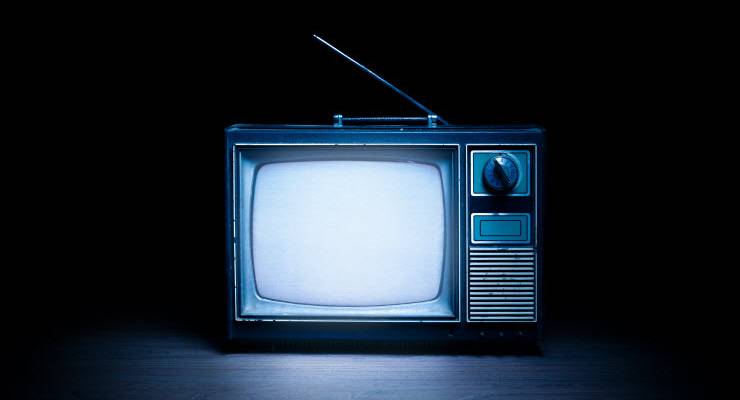
Remember the heyday of broadcast television when two or three networks decided how we spent our time? Suddenly the networks have lost their power, broken by the choice the internet offers as the end of mass television nears.
The once-struttingly proud free-to-air model is paddling hard to keep its head above water by holding on to an increasingly niche positioning in sport and news. But sport is wobbling and news sources are becoming more diverse.
As audiences fragment, ads are following. The most recent January figures suggest television ad spend was down 19.2% on last year. (Although last year was boosted by all those pre-election Morrison government puffs apparently.)
According to the latest government report on what we watch — and where we watch it — the once ubiquitous commercial television signals slid to just the third most accessed form of content on the box, well behind subscription and free streaming services. The result? We’re all watching different programming at different times — and prefer to pay for the convenience.
It’s fragmenting culture. According to Benedict Evans’ “The New Gatekeepers” released last week, there’s no such thing as a mass hit any more. In the 1950s, the highest rating shows reached two-thirds of households; in the 1980s, still about a third. Now? The most popular shows reach fewer than one in 10.
It’s not just the dense inventory on Netflix or Disney. It’s YouTube, too, which Evans estimates has similar total viewing numbers to Netflix and, with MrBeast, one of the top 15 streaming shows.
Looks like while we were busy worrying about COVID-19, we passed the pivot point. Broadcast television is no longer the preferred delivery channel of a mass culture. Now it’s just one of many drivers of the increasingly fragmented cultures of the 21st century.
According to last week’s report, only about half of us (53%) watched commercial television programs in the past seven days the way we’re expected to — when and where the networks decide. Even fewer (41%) watched the public broadcasters. But there’s mixed news for the ABC and SBS. The number of people watching their on-demand offerings — iview and SBS on Demand — is at 34%. How long until more people are regularly on iview than on the ABC free-to-air channels?
It’s a global trend. Evans estimates that in the US time spent on linear television is down by a third since 2015.
It’s time-shift meets exploding inventory as people decide when and what they watch. Now it looks like just about the only thing we want to watch “live” are things that aren’t easily able to be substituted and that we can’t readily time-shift, either because they lose currency (news and current affairs) or because they’re ruined by spoilers (sport or reality television).
The highest-ranked content-based reason for watching free-to-air is news: about 60% say it’s an “essential” or “main reason” for watching. This fits news consumption figures showing television is the main source of news for about 40%.
It’s a preference that skews old. The report says younger audiences are “significantly” less likely to even have a TV in their house.
Despite the big spends by the networks on sports rights, free-to-air sport watching is down, with a drift to streaming either through sports specialists such as Kayo or Optus Sports or the digital services of the commercial broadcasters.
All the data points to a continued drift from the heyday of linear television: most sets are now smart TVs or have some streaming plug-in (most common: Google’s Chromecast). More TVs are connected to the internet than are connected to broadcast aerials. Just half of all TVs turn on showing a free-to-air channel and only 41% of viewers chose a free-to-air channel as their first content.
It’s not just time-shifting and the embrace of choice. It’s advertising avoidance. About 70% of viewers with a paid subscription say it’s the essential or main reason for subscribing to streaming content. It explains why Netflix’s advertising trial is struggling. Don’t expect to see it rolled out in mature markets like Australia any time soon.
Meanwhile, expect the streaming side hustles of free-to-air broadcasters to become more like the main game. 9Now, for example, is already bringing in about one-eighth of the network’s television revenues. Expect, too, the free-to-air service to be even more of a promo for related streaming services, like Nine with Stan, or Ten with Paramount+.
And the ABC? As its viewers shift to iview, management and board — and government — need to be asking: how much changes when streaming becomes the corporation’s primary product? And what will that cost?
Do you still watch free-to-air TV? Let us know by writing to letters@crikey.com.au. Please include your full name to be considered for publication. We reserve the right to edit for length and clarity.








Sport has lead the move to streaming. There is hardly any major national sport available on free-to-air. You need a subscription to watch our national cricket team and to follow your local AFL, rugby league or rugby union team in their respective national comps.
News and current affairs has also gone but the slide has been more pernicious. Less than half the number of journalists are now employed in TV newsrooms and newspaper mastheads. Instead, TV news and current affairs is populated by good looking talking head presenters of a certain gender stereotype, and clerks who transcribe press releases from whichever political party is in power i.e. the one that monopolises the right to grant access to newsmakers.
And so TV news and current affairs is less about breaking news and more about trivia, gossip and propaganda.
For optimists, a hint of a better future is that independent invetigative journalist, youtuber Jordan Shanks, has a million subscribers to his Friendlyjordies platform. He monetises his subscriber base through Patreon, which enables him to fund defemation defences against the likes of Clive Palmer, John Barilaro, and CLubNSW which otherwise would have silenced him.
Shanks’ style is directly aimed at 20 – 30 year olds, which can be offputting for mature older people who don’t expect peurile jokes and unfamiliar cultural referencecs to intersperse what can only be described as fearless, unrelenting investigative journalism of the highest order.
Still, us older people who were brought up with an expectation of a free press printed on dead trees will not be part of the audience in decades to come, whereas todays 20 – 30 year old demographic will inherit the earth, so perhaps indie investigative reporting like Friendlyjordies is the future of News and Current Affairs.
Look for the trend to explode once Rupert is dead and his empire implodes.
Ironically the move of live sport from fta was led by people who wanted to view sports less parochial than Australia’s ‘major’ sports. A genuine ‘wide world of sports’ is available at last for those of us happy to pay.
I just love the freedom and flexibility of You Tube. Motoring, news, hobbies, history, how things are made, movies, some you have to pay for, old sitcoms and entertainment and like Jordan Shanks, much of it made in Australia, John Cadogan had a brutally honest motoring segment. That along with Crikey I estimate I spend 3 hours a night, flicking through segments of interest, haven’t missed free to air for about two years now.
I’m loving the shift away from Rupert and I honestly hope they continue to make themselves irrelevant as the world changes. I wouldn’t call Jordan Shanks a source of news though – I’m a young person and I can’t stand him. I wish I could but i would not call him a “fearless investigative journalist” – he is an amateur at best and needs to work on his ego. As much as I hate the ABC’s shift to the right, they get millions in taxpayers money to produce their programs that are infinitely better than Shanks’ shouting things at a camera in his bedroom. And his arrogance, as if he is the first and only journalist to have ever exposed corruption – he acts as if he’s the only one doing an honest job. Congrats to him for his million subscribers but give me professionalism and balance any day. for news on YouTube I prefer to stick to the likes of US-based creators like Philip Defranco and NowThis.
I’m still watching it despite a recent lurch for the even worse.
The death of broadcast/free-to-air is an assisted suicide.
Why are they allowed to get away with having so many channels and yet broadcast so much dross, often the same programs on multiple channels?
The regulation of the licences should be demanding a better service. This has been another monumental failure by successive federal governments but with the last one providing the worst of the shit sandwich.
My grandson thinks ABC Kids is amazing. You just turn it on and it’s there and you don’t even have to choose anything. When it finishes it’s time for bed.
Check out American cable. Hundreds of channels, all broadcasting rubbish.
Check out The Boss’ 30 yrs old “57 Channels (and Nothin’ On”.
Not just FTA tv, but their broader expanded media companies and relaxed regulation e.g. allowing them to cross media channels and have further reach, while acting as cartels of influence for and/or against government etc.
So, when things go pear shaped financially they cannot demand state bailouts as essential infrastructure, but abide by their own free market principles i.e. go bust &/or sell out at a significant loss.
Suicide by (often deliberately) irritating ads, butchering films and series for the ad $s. I haven’t watched fta for at least a decade.
It looks like I’m in the minority here. We’ll often record things we want to watch on free to air. Must be the old farts in us lol! I wonder where they get their figures from and if they’re current as the cost of living has squeezed all kinds of things out of daily life for so many people.
Recording free to air works for me, too, Jennifer. And I love fast-forwarding through the ads!
I recently discovered SBS World Movies which I think are wonderful for their diversity and superb entertainment value.
Agreed. There’s lots of good stuff on free to air if you’re prepared to search the programme guide and record for a convenient time.
I’m astonished it’s that high. It would have to be 15 years since I last watched a commercial network show while it was being broadcast. Possibly longer.
Re ads, every time I watch SBS On Demand I loudly pray for SBS to offer us an ad-free subscription model. Its ad breaks in its streaming shows are particularly clunky in their placement and full of very annoying, oft-repeated ads. I’d happily pay to avoid them.
It’s amazing that commercial free to air still lingers on. I recently tried to watch a movie on one of the digital stations and the experience of a battery of ads every 7-10 minutes made me rapidly give up. Why put up with that when there are so many streaming services these days?
Free to air TV and print publications are now very much legacy media which are no longer of interest to younger people. Their days are numbered.
It’s the ads that kerp it “free to air”.
….and free from viewers. You can’t possibly watch a movie, on free to air TV with around 30 minutes of station promos, and numbing repetitive adverts per hour. Fortunately we now have choice the TV stations are going to have to be innovative to keep any audience.
Good luck with your internet making streaming a movie a guaranteed possibility! I can’t tell you how often we have streaming that drops out.
According to The Mad Monk it’s only used for watching porn and is a waste of bandwidth, which is why he ordered his communications minster to destroy the NBN.